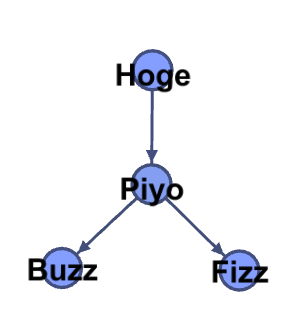GEXFはグラフをXMLで表現するフォーマットです.
Gephiなどで読むことができます.
例
単純な例を以下に示します.
<?xml version="1.0" encoding="UTF-8"?>
<gexf xmlns="http://www.gexf.net/1.2draft"
xmlns:xsi="http://www.w3.org/2001/XMLSchema-instance"
xsi:schemaLocation="http://www.gexf.net/1.2draft
http://www.gexf.net/1.2draft/gexf.xsd"
version="1.2">
<graph defaultedgetype="directed">
<nodes>
<node id="0" label="Hoge" />
<node id="1" label="Piyo" />
<node id="2" label="Fizz" />
<node id="3" label="Buzz" />
</nodes>
<edges>
<edge id="0" source="0" target="1" />
<edge id="1" source="1" target="2" />
<edge id="2" source="1" target="3" />
</edges>
</graph>
</gexf>
要素の説明
graph 要素
グラフを表します.
属性として defaultedgetype を指定することができます.
これは directed, undirected, mutual のいずれかの値をとり,edge のタイプが指定されなかった場合のデフォルト値を表します.
graph 要素は,子要素として nodes と edges と attributes を持つことができます.
attributes は上の例に出てきていないので後で説明します.
nodes 要素, node 要素
nodes はグラフの節点の集合を表します.
node はグラフのひとつの節点を表します.
node は属性として id と label を持ちます.
id は,その節点の識別子を表す文字列で,他の節点と同じ id を持つことはできません.
edges 要素,edge 要素
edges はグラフの辺の集合を表します.
edge はグラフのひとつの辺を表します.
edge は属性として id, type, label, source, target, weight を持ちます.
id は,その辺の識別子を表す文字列で,他の辺と同じ id を持つことはできません.
type は directed, undirected, mutual のいずれかの値をとり,edge の種類を表します.
source と target は,それぞれ辺の始点と終点の id です.
weight は辺の重みを表す float です.
attributes 要素,attribute 要素,attvalues 要素,attvalue 要素
節点や辺には,自由に情報を付加できるようになっています.
どうやって付加するのかは,以下の例をよく見れば大体わかると思います.
この例では,節点に kind という情報を付加し,辺に capacity と flow という情報を付加しています.
<?xml version="1.0" encoding="UTF-8"?>
<gexf xmlns="http://www.gexf.net/1.2draft"
xmlns:xsi="http://www.w3.org/2001/XMLSchema-instance"
xsi:schemaLocation="http://www.gexf.net/1.2draft http://www.gexf.net/1.2draft/gexf.xsd"
version="1.2">
<graph defaultedgetype="directed">
<attributes class="node">
<attribute id="0" title="kind" type="string">
<options>source|sink|others</options>
</attribute>
</attributes>
<attributes class="edge">
<attribute id="0" title="capacity" type="float" />
<attribute id="1" title="flow" type="float" />
</attributes>
<nodes>
<node id="0" label="Hoge">
<attvalues>
<attvalue for="0" value="source" />
</attvalues>
</node>
<node id="1" label="Piyo">
<attvalues>
<attvalue for="0" value="others" />
</attvalues>
</node>
<node id="2" label="Fizz">
<attvalues>
<attvalue for="0" value="others" />
</attvalues>
</node>
<node id="3" label="Buzz">
<attvalues>
<attvalue for="0" value="sink" />
</attvalues>
</node>
</nodes>
<edges>
<edge id="0" source="0" target="1">
<attvalues>
<attvalue for="0" value="2.0" />
<attvalue for="1" value="1.0" />
</attvalues>
</edge>
<edge id="1" source="1" target="2">
<attvalues>
<attvalue for="0" value="1.0" />
<attvalue for="1" value="0.0" />
</attvalues>
</edge>
<edge id="2" source="1" target="3">
<attvalues>
<attvalue for="0" value="1.0" />
<attvalue for="1" value="1.0" />
</attvalues>
</edge>
</edges>
</graph>
</gexf>
attributes 要素によって,付加する情報のスキーマを定義し,attvalues 要素で節点や辺に値を付加しています.attribute 要素の type 属性には integer, long, double, float, boolean, liststring, string, anyURI が指定できます.
また,options 要素で取りうる値を制限できます.
参考文献
ここで紹介した以外にもまだいくつか機能があります.興味がある人は以下のPDFを読むとよいと思います.
